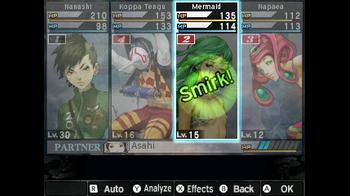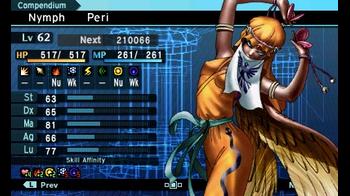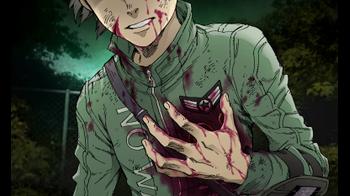Shin Megami Tensei IV: Apocalypse Review
Three years ago, the original Shin Megami Tensei IV game released overseas. It told the tale of Flynn - a Samurai who hailed from the Eastern Kingdom of Mikado that resided above a catastrophic Tokyo. He ultimately found himself in a struggle between the armies of law versus chaos headed by Merkabah and Lucifer respectively.
Shin Megami Tensei IV: Apocalypse is a somewhat odd follow-up. It’s best described as a standalone expansion pack that begins during the neutral path’s events of the previous game. Even though playing Shin Megami Tensei IV is by no means mandatory to understand the events in Apocalypse, new players may feel lost at first.
Players take on the role of Nanashi, a rookie from the Hunter Association down in Tokyo. He’s initially tasked with easy chores along with his childhood friend, Asahi. Unfortunately, living with demons running amok has its downsides as he finds himself dead in the first few minutes of the game.
Don’t worry - Apocalypse doesn’t end there!
Instead, Nanashi luckily receives another shot at life thanks to his encounter with the enigmatic Dagda in the afterlife. This resurrection comes at a price though; Nanashi basically becomes Dagda’s puppet to carry out his schemes. Nanashi not only obtains goofy neon-green markings all over his body during this exchange; he also gains the power to summon demons.
Apocalypse is a big second chance to refine the concepts and ideas introduced in Shin Megami Tensei IV. It alters a lot of the systems from the original game in smart ways that not only address core problems but also vary up gameplay mechanics as well.
The biggest change in Apocalypse lies in its expanded partner system. SMT IV often had Flynn working alone in battle with a few exceptions. In Apocalypse, Nanashi is almost always accompanied by various allies throughout the course of the story; they level up with you and gain new abilities. Each partner specializes in different things - Asahi in healing, Navarre in buffs, Nozomi in gun attacks, and so on.
New to Apocalypse is the support gauge for these partners as well. Landing an attack, buffing, and healing will increase it and once full, support attacks not only automatically disable the enemy for a turn, but also lets your allies land an all-out attack on the enemy. It helps give a bit of breathing room to lay down another assault or properly set up more defenses against foes.
I quite enjoyed this change of pace from SMT IV; Apocalypse is more intertwined with its supporting cast who each develop in fantastic directions. Their personal involvement within the maelstrom of events led to compelling personalities that grew more likable. I was stunned with the writing for these characters.
Even the returning cast members from SMT IV had an intriguing perspective placed upon them. Witnessing the actions of Flynn from the sidelines shined a new angle on him as I got to hear how each of the different groups feel about his efforts to save Tokyo. There’s a unique dichotomy on witnessing events from the perspectives of Flynn and Nanashi - two main characters that come from very different places.
SMT IV’s Smirk system has been massively reworked in Apocalypse. Previously, it was infamous for massively deciding the tide of battle in unfair ways. A frustrating example of this was a boss battle in SMT IV where your ally would cast a spell that it nulled, granted it a Smirk, and wiped your entire party in a single turn before you could act.

Thankfully, this kind of situation no longer happens in Apocalypse because partners can no longer Smirk an enemy. Instead, they'll often resort to using your items if their abilities will clash with an enemy's attributes. There are even spells that both give and take away Smirk.
Smirks still work both ways by hitting a weakness, or nulling/reflecting an incoming attack. This status continues to grant a guaranteed critical hit on the next attack while temporarily shielding the user from their weakness. Its most significant alteration comes in giving attacks and spells additional effects.
The light and dark elements of Hama and Mudo, for instance, no longer instant kill normally in Apocalypse. They both inflict damage normally like elemental spells, but regain the ability to instant kill if they’re used when the caster is in Smirk status. Thus, their accuracy to hit is much more akin to elemental spells now.
Another major improvement that Apocalypse brings to the table is its new Mapper tool. Trying to figure out where to go next in SMT IV was a bit confusing at times, especially if you took a break from playing it for awhile; it didn’t have any visual cues to spell out where you had to go next. Apocalypse’s Mapper tool not only provides a detailed map with location names, but has a button that points exactly to where players should be heading to next. It’s incredibly convenient and should’ve been there in the first place.
Demon fusion has also received slight changes as well. The ability to freely select any skill to transfer from SMT IV was a welcome change, but it ended up in me crafting identical movesets for everyone in my party. There was no incentive for me to build a demon one way or the other; it was easier for me to keep improving the same set of skills with more powerful versions of them in stronger demons.

In Apocalypse, each demon has a set of affinities that they’re more well-suited to use than others - a Jack Frost’s ice spells will be more powerful than a Pyro Jack’s ice spells. The higher the affinity rating to a particular set of skills, the less MP it’ll take to cast. It’s an intelligent way to encourage building demons more in-line with their appropriate combat affinities instead of a one-size-fits-all toolkit.
Shin Megami Tensei IV: Apocalypse’s one major downfall is that it is simply too identical to the previous game in its environments. While there’s a handful of new dungeons, the vast majority of the game is revisiting places with the exact same map layouts as its predecessor. If you’ve played SMT IV recently, be prepared for a huge dose of déjà vu as you run around Tokyo once more.
From the overworld map to the various districts and buildings, Apocalypse is pretty much visually identical to SMT IV. It doesn’t introduce anything necessarily innovative to the mainline series, but it’s a very good entry in the mainline Shin Megami Tensei series.
I’m a big fan of the neutral route in these games, so seeing a whole game explore the different shades of gray that lay within that path is particularly fascinating to me. There are clashing ideologies among the standard law and chaos influences; the gap between both extremes is vast and Apocalypse surprised me in how it explored that space.
Apocalypse’s English voicework are great all around, but Dagda’s voice especially stood out to me. He’s much like a devil that sits on your shoulder that makes snarky remarks and generally improves any scene that he gets a chance to speak in. I also particularly enjoyed Lucifer’s English performance as well due to his constant slight sarcastic tinge.
Plus, the original soundtrack in this game is absolutely a blast to listen to. Mixing urban tones to gradually upheaving tempos got my blood pumping in combat. Even the main battle theme keeps things fast-paced with a sense of urgency while some of the more major boss battles gave off an appropriately ominous, dreaded atmosphere. It’s all quite lovely.
To those worried about the multiple ending requirements in Apocalypse, it’s a much more simple process this time around. Getting onto the Neutral path in SMT IV involved a weird invisible system of checks and balances through dialogue options. The method is more streamlined in Apocalypse with some fun twists mixed into it.
Shin Megami Tensei IV: Apocalypse improves upon Shin Megami Tensei IV’s systems by redesigning mechanisms that transform previous problems into core strengths. Though its core framework and interface systems are pretty much straight out of SMT IV under a new coat of paint, its new cast and story kept things captivating. I adored its successive efforts to make each member of the group someone I ultimately cared about.
It’s an obvious second try to rectify the problems of the former game, but it is damn fine excellent one.

